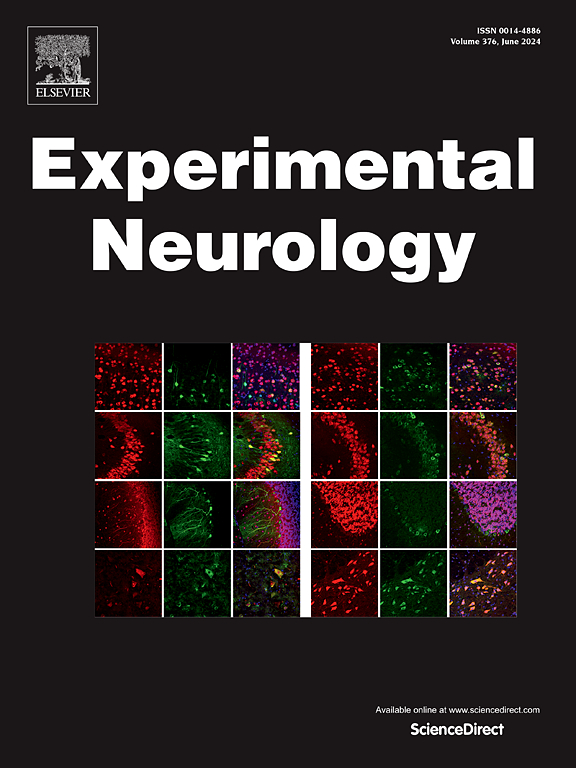Repetitive cortical spreading depolarizations are prolonged early after experimental traumatic brain injury
IF 4.6
2区 医学
Q1 NEUROSCIENCES
引用次数: 0
Abstract
Cortical spreading depolarizations (CSDs) are the most common electrophysiological dysfunction following a traumatic brain injury (TBI), and clustered CSDs (≥3 CSDs in 2 h) are associated with poor outcomes 6 months after TBI. While many experimental studies have investigated a single CSD after injury, no known studies have investigated how time after injury affects the characteristics and impact of a CSD cluster. This study sought to determine the characteristics of a cluster of repetitive CSDs when induced at three different time points after moderate experimental TBI. Adult male Sprague Dawley rats underwent a lateral fluid percussion or sham injury, and repetitive CSDs were induced 0-, 3-, or 7-days post injury (dpi). Properties were analyzed from 2-h-long electrocorticographic (ECoG) and laser Doppler flowmetry (LDF) recordings. We did not observe deterioration of CSDs (2-Way ANOVA, p = 0.3572), depressions of background electrical activity (p = 0.0991), or hemodynamic responses (p = 0.1298) over the course of the recording. Repetitive CSD direct current shift durations were the longest when induced at 0dpi (p = 0.0161), while the durations of CSDs induced at 3dpi and 7dpi were similar to CSD durations in uninjured tissue (p = 0.9857). No differences were seen in the depression of background activity duration (p = 0.1901), and normal hemodynamic responses were observed at each time point. These findings confirm that CSDs are prolonged in impaired tissue and suggest that the impaired tissue may be more at risk of further damage when repetitive CSDs occur early after injury.
重复性皮层扩张性去极化在实验性颅脑损伤后早期延长。
皮质扩张性去极化(CSDs)是创伤性脑损伤(TBI)后最常见的电生理功能障碍,聚集性CSDs(2 h内≥3个CSDs)与TBI后6 个月的不良预后相关。虽然许多实验研究调查了损伤后的单个CSD,但没有已知的研究调查损伤后时间如何影响CSD集群的特征和影响。本研究旨在确定中度实验性脑损伤后在三个不同时间点诱导的一组重复性脑卒中的特征。成年雄性Sprague Dawley大鼠接受外侧液体冲击或假性损伤,并在损伤后0、3、7天(dpi)诱导重复性CSDs。通过2小时长皮质电图(ECoG)和激光多普勒血流仪(LDF)记录分析其性质。在整个记录过程中,我们没有观察到CSDs恶化(2-Way方差分析,p = 0.3572)、背景电活动下降(p = 0.0991)或血流动力学反应(p = 0.1298)。0dpi诱导的重复性CSD直流电位移持续时间最长(p = 0.0161),而3dpi和7dpi诱导的CSD持续时间与未损伤组织相似(p = 0.9857)。背景活动持续时间的抑制无差异(p = 0.1901),各时间点血流动力学反应正常。这些发现证实了CSDs在受损组织中是延长的,并且表明如果损伤后早期发生重复CSDs,受损组织可能更有进一步损伤的风险。
本文章由计算机程序翻译,如有差异,请以英文原文为准。
求助全文
约1分钟内获得全文
求助全文
来源期刊

Experimental Neurology
医学-神经科学
CiteScore
10.10
自引率
3.80%
发文量
258
审稿时长
42 days
期刊介绍:
Experimental Neurology, a Journal of Neuroscience Research, publishes original research in neuroscience with a particular emphasis on novel findings in neural development, regeneration, plasticity and transplantation. The journal has focused on research concerning basic mechanisms underlying neurological disorders.
 求助内容:
求助内容: 应助结果提醒方式:
应助结果提醒方式:


